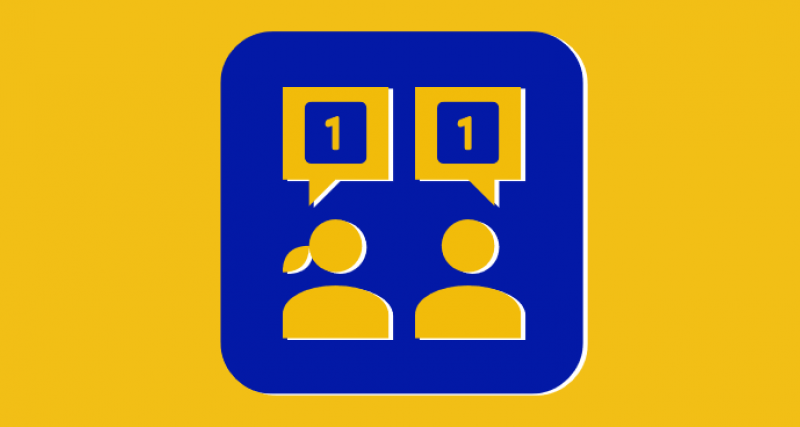How to unlock value from your one-on-one sessions
I’m consistently surprised by how few managers and executives have a game plan for their one-on-one sessions with team members. Just ask those people, as too many describe these sessions with the boss as infrequent or inconsistent, ineffective and, in some cases, intolerable.
That’s too bad. For everyone in a leadership role, one-on-one time with your team members is precious real estate on your calendar. These sessions, when appropriately run, offer both boss and employee an opportunity to pause, breathe, reflect, strengthen rapport and re-energize for current and expected challenges.
In this article, I share ideas on how managers and their team members can structure and facilitate quality one-on-one sessions that all parties appreciate.
Here are seven ideas to unlock the value from your one-on-ones:
1. Reframe (together) the purpose of your one-on-ones
For both parties, it’s essential to define one-on-ones as opportunities to share ideas, identify opportunities and zero in on solutions to vexing problems.
I encourage managers to work hard to let their team members know that one-on-ones are not trials, judgment sessions or, worse yet, meetings where they should feel yet again compelled to justify their existence.
Frame the sessions as essential opportunities for both parties to work on the business at hand and support each other. You’ll be positively surprised how interesting, valuable and looked-forward-to they become.
Leaders, consider working with your team members to define a charter for your one-on-ones. Start with: “The purpose of our one-on-one sessions is to…” Have fun completing this exercise together.
2. Tailor timing and frequency to their needs
I learned this lesson the hard way. I’m a morning person by nature and enjoy the early-morning sessions with team members to calibrate and offer support.
After an organizational change, I had two new managers reporting to me. One seemed to thrive with our early interchanges early on Tuesday mornings. However, the other individual was sending signals that suggested talking with me was not a priority. I asked what I was doing wrong. His frank feedback taught me a valuable lesson:
“You’re literally the last person I want to talk to in the morning. I’ve got my game plan lined up, and I’m working with my team members to execute our plan. I feel distracted. However, later in the day, I appreciate the chance to share what worked, what didn’t and to explore ideas on what I can do differently going forward.”
Ouch! Lesson learned.
Managers, work with your team members to understand their schedules and preferences and flex to their timing and frequency needs.
3. Beware the gravitational pull of status updates
One of the biggest mistakes I see managers make is compartmentalizing one-on-one sessions as simply status updates. The manager views the one-on-one as an opportunity to understand better what’s going on and what the employee is doing to move things forward. Those aren’t in and of themselves wrong; they’re just not a great use of precious one-on-one time.
Solve the status update problem outside of the one-on-one session. Use dashboards or other project tools to communicate status and reserve this precious time for addressing challenges, uncovering opportunities and light coaching.
An interesting byproduct of managers not making employees feel that they are justifying their existence or replaying their greatest hits of the past week is an increase in trust. Showing that you trust your team members to manage their business, communicate problems if needed and live up to commitments is rocket fuel for performance.

4. Set the tone for creativity from the start
I love when these sessions kick off with something other than “How’s it going?” To stimulate creativity for her one-on-ones with employees, one manager used the question, “What’s one idea you or your team members have that seems a little crazy and potentially really valuable?”
This manager’s “one idea” approach ensured the sessions start on a divergent thinking note. Instead of “It’s going fine,” the one-on-ones began with energy and ideas and then mutual brainstorming on how to bring them to life as experiments.
Try your twist on this question and open the creative floodgates from the beginning of your one-on-one sessions.
5. Share and create context in one-on-ones
Performance is always the goal of manager and employee interaction, and few things stimulate performance more effectively than arming people to understand how their work fits into the bigger picture.
One manager I know allocates 10 minutes in a 60-minute one-on-one to share what he’s learned about the organization’s strategy, key performance indicators and marketplace issues. The follow-on discussion focuses on ensuring the employee’s work efforts are aligned with the organization’s and makes sure all parties see how they connect to the bigger picture.
Another manager personalizes this process by offering “Here’s what I’m excited about for our business,” and “Here’s what’s keeping me awake at night about our situation.” The transparency and authenticity in both of these statements strengthen the quality of the discussions.
Choose an approach that fits you, but strive in every one-on-one session to share what you’ve learned, and then help the employee connect it to their work.
6. Rotate responsibility for leading the sessions
I love the idea of alternating responsibility for facilitating the sessions between manager and employee. This simple adjustment in approach turns these meetings into learning opportunities for all parties and keeps the interchanges fresh and relevant.
One senior manager offered, “It takes a lot of critical thinking to choreograph a quality one-on-one. When it’s a team member’s turn, they have to decide what’s important and what they want to gain from this exchange.”
For the manager, this simple twist in meeting ownership offers insights into the employee’s situation and helps identify coaching and development ideas.
7. Don’t be afraid to free-form your one-on-ones
I’ve long believed variation is the food of creativity, and routine the drag on innovation. Instead of letting your one-on-one sessions fall victim to the tyranny of the repeating meeting on your calendar or the same old format, mix things up.
You can change locations, change your medium, change the timing, change the agenda or all of the above. Some of my best one-on-ones have been walking sessions, shared taxi rides or lunches. If you give me truth serum, the walking sessions are the best. If you’re remote, both of you push away from the camera, pop in the earbuds and head out for a walk and start sharing. In a few instances, we’ve thrown the agenda out the window based on the opening prompter, or we’ve adjusted to focus on real-time challenges and opportunities.
What about career development in one-on-ones?
Career development is an agile project, best handled opportunistically and frequently. You will find opportunities in your one-on-ones to coach, share ideas on next steps or new initiatives and that’s great. However, don’t reduce career development to just a standing agenda item. Seek other opportunities to cover this important topic beyond the one-on-ones.
The bottom line
You want to send employees out of your one-on-ones with fresh ideas, a growing sense of belief that you trust them, and the tools and support they need to push essential items forward. Alternatively, you as the manager want to know that you’ve created clarity around strategies and goals and gained an opportunity to both coach and support someone.
With both of you working together, the one-on-ones might just become the most critical engagements on either of your calendars.
Source: https://www.smartbrief.com/original/2021/05/how-unlock-value-your-one-one-sessions




